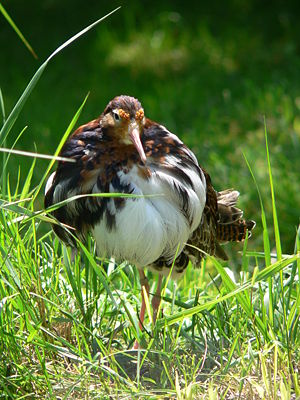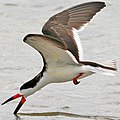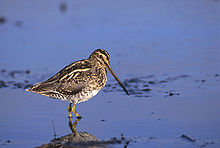Plover-like
| Plover-like | ||||||||||||
|---|---|---|---|---|---|---|---|---|---|---|---|---|

Ruff ( Philomachus pugnax ) |
||||||||||||
| Systematics | ||||||||||||
|
||||||||||||
| Scientific name | ||||||||||||
| Charadriiformes | ||||||||||||
| Huxley , 1867 |
The plover-like (Charadriiformes), also called Limikolen or wading birds , are an order of birds . Very different families and genera belong to it .
features
The plover-species are a diverse group in appearance, but they are similar in some basic characteristics.
In all species the roof of the mouth and the vocal apparatus are almost the same, the sternum has no inwardly pointing bony processes; there are also similarities in the structure of the foot, more precisely: similarities in the tendons in the lower leg and foot. The wing has eleven hand wings , there are control springs at least twelve, but up to twenty-six. The feathers on the trunk have an aft shaft. The rump gland is characterized by a long head of feathers. The large nasal glands, which are used to excrete excess salt in marine species, are particularly important. They are very pronounced in the vaginal beaks . While the three front toes are normally built, the rear toe is higher up on the foot, is usually short, and often does not touch the ground; it can also be absent. The latter is the case with avocets and stilt-walkers , some plovers , auks, and the kittiwake . Most of the species of the suborders Charadrii and Scolopaci have free toes, but webbed avocet relatives are present to some extent, and the three treadmill species , the egret and all gulls , skuas, and alks have full webbed toes.
Since the majority of the plover-like migratory birds or at least occasional long-haul fliers, they usually have long, thin wings that taper to a point. Exceptions are the lapwings with their widened to tip (Engl. Lapwing ) and the alkene with shortened wings as adjusting to life as a diver on the high seas. An extreme example of this is the exterminated, flightless giant alk .
With a body length of 11 centimeters and a weight of 23 to 37 grams, the sandpiper is the smallest species, the largest is the black-headed gull , which is 64 to 78 centimeters long and 1.3 to 1.8 kilograms in weight. Except for the goldcock , water treadmill, stilt and ruff , there is no sexual dimorphism in the plumage. In some families, however, the females are larger (e.g. jacana , oystercatcher ).
Hybridizations between individual species within the suborders Charadrii and Scolopaci are rare, but possible. The hybrids are intermediate colored and built. There have been observations of hybrids of Calidris sandpipers , lapwing, pluvialis plover , avocet relatives and oystercatchers. With seagulls are seen more frequently intermarried and crossings of different species.
Development and moulting cycle

On the way to fledging, the young birds undergo a first change of plumage. The fine, branched down feathers are exchanged for a youth dress with fully developed flight feathers. The next moult is the postjuvenile moult. It is partially as a rule, there are only changed the body feathers and a few flight feathers in Jacana, Brachschwalbe-like and the Buff-breasted Sandpiper however, it is a complete moult. The plumage that has now been acquired consists only of new feathers - or of new and old feathers. The latter look clearly worn, making it easy to determine the age. The moult from the first winter dress to the first summer dress is often partial. The smaller wader species breed in the second calendar year, larger species such as oystercatchers only after two to three years. There are three types of development in seagulls. Small species like the black-headed gull are fully grown in the second year ( two-year- old gulls ), medium-sized ones like the common gull at three years old ( three-year- old gulls ) and the largest only reach maturity in the fourth year ( four-year-old gulls ). If the hormone cycle is disrupted, immature birds can be observed in winter or summer dress at an inappropriate time of year.
After putting on the youth dress, the beak of many waders continues to grow for several months. The difference is not very big, but can be clearly seen when comparing adult and young birds in the wild, especially with long-beaked species such as curlews .
To determine the age of not yet sexually mature birds, the color of the iris and the size and color of the bare eye ring (if any) can also be used.
Way of life
Plumage care
The typical repertoire of plumage care includes bathing in suitable water spots and plucking the feathers with the beak. The oily secretion from the beak is distributed throughout the plumage with the beak in order to achieve a water-repellent surface. Head and neck, i.e. places that cannot be reached with the beak, are worked on with the foot. For scratching, the foot is led around above or below the wing, depending on the type.
activity

Most plover species, especially plovers, snipe birds, and gull relatives, are active during the day. There are also some species that prefer to hunt at night or in the twilight. For example, goldcock are mostly active mornings and evenings, and fairy terns also hunt at dusk. The activity phases of snipes of the genus Gallinago , triels and the egret are almost exclusively at night . Birds that live on tidal flats, regardless of the day-night rhythm, search for food when the tide is low, since only then do the seabeds containing prey fall dry.
nutrition
The food of the plover-like is mainly animal, only the South American high altitude runners only eat seeds and have an adapted digestive tract. Curlews also ingest berries from low shrubs and sheaths and skuas prey on almost anything up to the size of small birds. The waders, especially snipe birds, stride through shallow water and over muddy surfaces and poke their beak in the ground. There are many nerve endings at their beak tips, because the sense of touch plays a major role in tracking down prey. In addition, the beak halves are very flexible, which makes poking easier.
Different variants of food acquisition:
Steppe mudbirds poking around
Wading greenshanks
Avocet the percolation of water and sludge
Arctic tern looks for fish from the air.
Arctic skua works as a scavenger on an animal carcass.
Plover (here: ringed plover ) run along the flushing rim and peck their prey from the ground.
Scissors' beaks catch fish with their mandibles extended.
The foraging for food often takes place in communities of conspecifics. American avocets , for example, run around in closed groups in the water catching small fish. Plover have a short beak for ingesting food from the ground. They look out for insects and other small animals, then quickly run up to their prey and peck for them. Now and then they step on the spot to scare away invertebrates.
In addition to the water treaders, who always swim in search of food, avocets and water striders of the genus Tringa show this behavior. The turnstone and the crooked-billed plover have a special way of foraging for food . The former pushes stones around with its flat spatula beak to collect the small animals hidden underneath, while the latter cleverly turns over stones with its one-sided - mostly to the right - curved beak. Skuas are active in the predatory hunt, for example they force other birds to strangle devoured prey. Most terns are dive divers.
Reproduction
Many plover species breed in colonies. The nest is almost always a hollow in the ground that can be sparsely covered with nesting material. Only tropical terns and the wood sandpiper breed in trees. Usually one to six eggs are laid and the incubation period is two and a half to four weeks. If the first clutch is lost, a replacement brood can occur, but with a lower number of eggs. The racing bird breeds twice a year. As the only type of digs Reiherläufer a breeding tube in the sand, his boys are Nesthocker. The young birds of all other plover species are nest-fleders, which leave the nest after a few hours or days, or at least place stools that stay near the nest. All chicks are colored after hatching. After leaving the nesting site, they will continue to receive food from their parents. The rearing of the young is done by both sexes, with the Calidris sandpipers and the Mornell ringed plover it is mainly the male. The classic gender roles are reversed in the case of water treaders and goldcock. Here the female advertises for the male, who alone raises the young. Crocodile watchers and tropical terns cool their offspring when it is very hot with water carried in their abdominal plumage.
Habitat and Distribution
Plover species can be found worldwide, even in the cold regions near the poles . Many live near the water on the coast of the sea, lakes, rivers and swamps, but also in dry regions such as semi-deserts, steppes and high mountains. Almost all species are migratory birds.
Internal system


Classically, the plover-like were previously split into three sub-orders, the waders, seagulls and alken birds. Occasionally these taxa were also interpreted as separate orders.
New phylogenetic analyzes have shown that there are three main lines within the plover species, the Lari (seagulls and relatives), the Scolopaci (snipe birds and relatives) and the Charadrii (plover and relatives):
-
Plover-like (Charadriiformes)
- lari
- Alkenbirds (Alcidae)
- Skuas (Stercorariidae)
- Laridae ( seagulls , terns, and scissor beaks )
- Curlews (Glareolidae)
- Reiherläufer (Dromadidae)
- Rotary chicken (Turnicidae)
- Scolopaci
- Snipe birds (Scolopacidae)
- Blatthühnchen (Jacanidae)
- Golden snipe (Rostratulidae)
- Steppe runner (Pedionomidae)
- High altitude runner (Thinocoridae)
- Charadrii
- Plover (Charadriidae)
- Avocets (Recurvirostridae)
- Oystercatcher (Haematopodidae)
- Ibis beaks (Ibidorhynchidae)
- Crocodile Guardian (Pluvianidae)
- Triele (Burhinidae)
- Sheathbills (Chionididae)
- Magellanic plover (Pluvianellidae)
- lari
The exact family relationships are shown in the following cladogram :
| Charadriiformes |
|
|||||||||||||||||||||||||||||||||||||||||||||||||||||||||||||||||||||||||||||||||||||||||||||||||||||||||||||||
|
|
The run chickens and the steppe runner, which are mostly assigned to the crane birds , are now placed in close relatives to the seagulls and the snipe birds. The terns, gulls and scissorsbills can no longer exist as separate families.
Individual evidence
- ↑ Jahn, p. 89
- ↑ a b Niethammer, p. 138 (G. Niethammer)
- ↑ Jahn, p. 149
- ↑ a b Jahn, p. 161
- ^ Forshaw, p. 102
- ↑ Jahn, p. 91
- ↑ Chandler, p. 21
- ↑ Olsen, Larsson, pp. 14-17
- ^ Chandler, p. 16
- ↑ Chandler, p. 17
- ^ Chandler, p. 19
- ↑ Chandler, p. 15
- ↑ Chandler, p. 13
- ↑ Chandler, pp. 33-34
- ^ Forshaw, p. 107
- ^ Forshaw, p. 112
- ↑ Jahn, p. 156
- ↑ Chandler, p. 23
- ↑ Chandler, p. 24
- ↑ Chandler, pp. 29-30
- ↑ Chandler, p. 31
- ↑ Chandler, p. 32
- ^ Forshaw, p. 109
- ^ Forshaw, p. 111
- ^ GH Thomas, MA Wills, T. Szekely: A supertree approach to shorebird phylogeny. In: BMC Evolutionary Biology. London 2004; 4: 28th ISSN 1471-2148
- ^ A b John Harshman, Joseph W. Brown: Charadriiformes. Shorebirds and relatives. In: The Tree of Life Web Project. 2008.
literature
- Peter Colston , Philip Burton: Limicolen. All European wader species, identifiers, flight patterns, biology, distribution . BLV Verlagsgesellschaft, Munich 1988, ISBN 3-405-13647-4 .
- Richard Chandler: Shorebirds of the Northern Hemisphere . Christopher Helm , 2009.
- Klaus Malling Olsen, Hans Larsson: Gulls of Europe, Asia and North America . Christopher Helm, 2003.
- Günther Niethammer and many others: The waders and seagulls - plover-like - seagull-like and alken . In: Bernhard Grzimek (ed.): Grzimeks animal life. Encyclopedia of the Animal Kingdom . tape 8 : Birds 2 (edited by Bernhard Grzimek, Wilhelm Meise, Günther Niethammer, Joachim Steinbacher). Kindler Verlag, Zurich 1969, p. 138–235 (= chapters 6–8) (paperback edition: dtv, Munich 1980 and 1993).
- Theo Jahn: Brehm's new animal encyclopedia . Herder, Freiburg im Breisgau, Prisma, Gütersloh 1982, ISBN 3-570-08606-2 .
- David Burnie: Animals. The great image encyclopedia . Dorling Kindersley, Munich 2001, ISBN 3-8310-0202-9 .
- Colin Harrison, Peter Castell: Fledglings, Eggs and Nests of Birds in Europe, North Africa and the Middle East . 2nd Edition. Aula Verlag GmbH, Wiebelsheim 2004.
- Joseph Forshaw : Encyclopedia of Birds. Weltbild Verlag GmbH, Augsburg 1999, ISBN 3-8289-1557-4 .
- Svensson, Grant, Mullarney, Zetterström: The new cosmos bird guide . Franckh-Kosmos Verlags-GmbH & Co. KG, Stuttgart 1999, ISBN 3-440-07720-9 .












